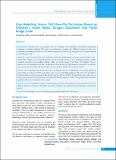Please use this identifier to cite or link to this item:
https://hdl.handle.net/20.500.14356/1212| Title: | Live Modeling Versus Tell-Show-Do Technique Based on Children’s Heart Rates, Oxygen Saturation and Facial Image Scale |
| Authors: | Limbu, Senchhema Dikshit, Parajeeta Malla, Manisha Parajuli, Pragya Mehata, Suresh |
| Citation: | LimbuS., DikshitP., MallaM., ParajuliP., & MehataS. (2022). Live Modeling Versus Tell-Show-Do Technique Based on Children’s Heart Rates, Oxygen Saturation and Facial Image Scale. Journal of Nepal Health Research Council, 19(04), 797-804. https://doi.org/10.33314/jnhrc.v19i04.3940 |
| Issue Date: | 2021 |
| Publisher: | Nepal Health Research Council |
| Article Type: | Original Article |
| Keywords: | Facial image scale live modeling oxygen saturation pulse rate tell-show-do |
| Series/Report no.: | Oct-Dec, 2021;3940 |
| Abstract: | Abstract Background: Tell-Show-Do is most popular and Live modeling is less frequently used behavior management techniques in pediatric dentistry. This study was conducted to compare the children’s response to these two techniques by measuring the objective and subjective parameters of anxiety by using pulse rate, oxygen saturation and facial-image scale. Methods: A cross-sectional study was conducted among 138 children aged 5-10 years from December 2020 - August 2021. Children were randomly divided into three groups: Group A: Live modelling technique (mother as model), Group B: Live modelling technique (father as model), Group C: Tell–Show–Do technique. All were subjected to oral examination and rotary prophylaxis on first dental visit. Pulse oximeter was used to record heart rate, oxygen saturation along with facial-image scale scores before and after the treatment period. Results: The average heart rate at the end of rotary prophylaxis session was significantly lower among children in group A than in group C (p=0.05). facial-image scale scores revealed high significance after the rotary prophylaxis treatment and it was lower in group A than group C and group B (p< 0.001). Average facial-image scale scores of fear perception by girls in group A was lower than group C and group B (p< 0.001). Oxygen saturation showed no significant differences between the three groups. Conclusions: Live modelling is equally worth practicing as Tell Show Do technique to decrease the anxiety level of children. Anxiety level increased during the procedural work than oral examination and facial image scale indicated anxiety. Keywords: Facial image scale; live modeling; oxygen saturation; pulse rate; tell-show-do. |
| Description: | Original Article |
| URI: | http://103.69.126.140:8080/handle/20.500.14356/1212 |
| ISSN: | Print ISSN: 1727-5482; Online ISSN: 1999-6217 |
| Appears in Collections: | Vol. 19 No. 04 (2021): Vol 19 No 4 Issue 53 Oct-Dec 2021 |
Files in This Item:
| File | Description | Size | Format | |
|---|---|---|---|---|
| 3940-Manuscript-26792-1-10-20220313.pdf | Fulltext Download | 231.84 kB | Adobe PDF |  View/Open |
Items in DSpace are protected by copyright, with all rights reserved, unless otherwise indicated.
